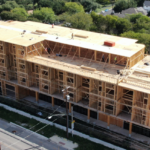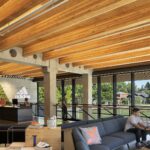Expert Tips
Using Dead Loads to Resist Shear Wall Overturning
Can any dead loads be used or do they need to occur directly over the hold downs?
Structure dead loads, reduced according to the requirements of ASCE 7 Chapter 2, can be used to resist shear wall overturning. These resisting dead loads are commonly applied to the top of the shear wall as uniform loads (for example the dead load of a floor being supported by the shear wall) which are often simplified into concentrated loads at the center of the wall.
Section 4.3.6.4.2 of the American Wood Council’s Special Design Provisions for Wind and Seismic (SDPWS) alludes to the fact that dead load can be used as a stabilizing moment to resist shear wall overturning:
4.3.6.4.2 Uplift Anchorage at Shear Wall Ends: Where the dead load stabilizing moment is not sufficient to prevent uplift due to overturning moments on the wall (from 4.3.6.1.1 or 4.3.6.1.2), an anchoring device shall be provided at the end of each shear wall.
The text, Design of Wood Structures, by Breyer et. al also indicates that the use of dead loads to resist shear wall overturning is commonly accepted as wood industry standard. It includes the following narrative:
Some engineers will include overturning resistance due to dead load in the FBD [free body diagram], while other engineers will neglect the dead load resistance. Neglecting the dead load results in a simpler calculation, and corresponds well with testing indicating that shear wall capacity is influenced little by resisting dead load. Including the dead load results in a reduced uplift reaction.
Unless a shear wall is very long (which is uncommon these days), it is typically considered as a rigid body, where dead loads will be transferred into the tension and compression boundary members. Several texts ignore the application of dead loads to simplify the analysis, but examples exist which show that a wall can be under-designed by doing so. It is important to note that with only a very few exceptions, none of the shear wall tests completed to date include the application of dead loads. Therefore omission of the dead loads in the analysis would more closely match the tested configurations. Ultimately it’s up to the Structural Engineer of Record to decide whether or not dead load is included as resisting shear wall overturning. However, it is acceptable to do so as indicated in the above cited section from SDPWS.


